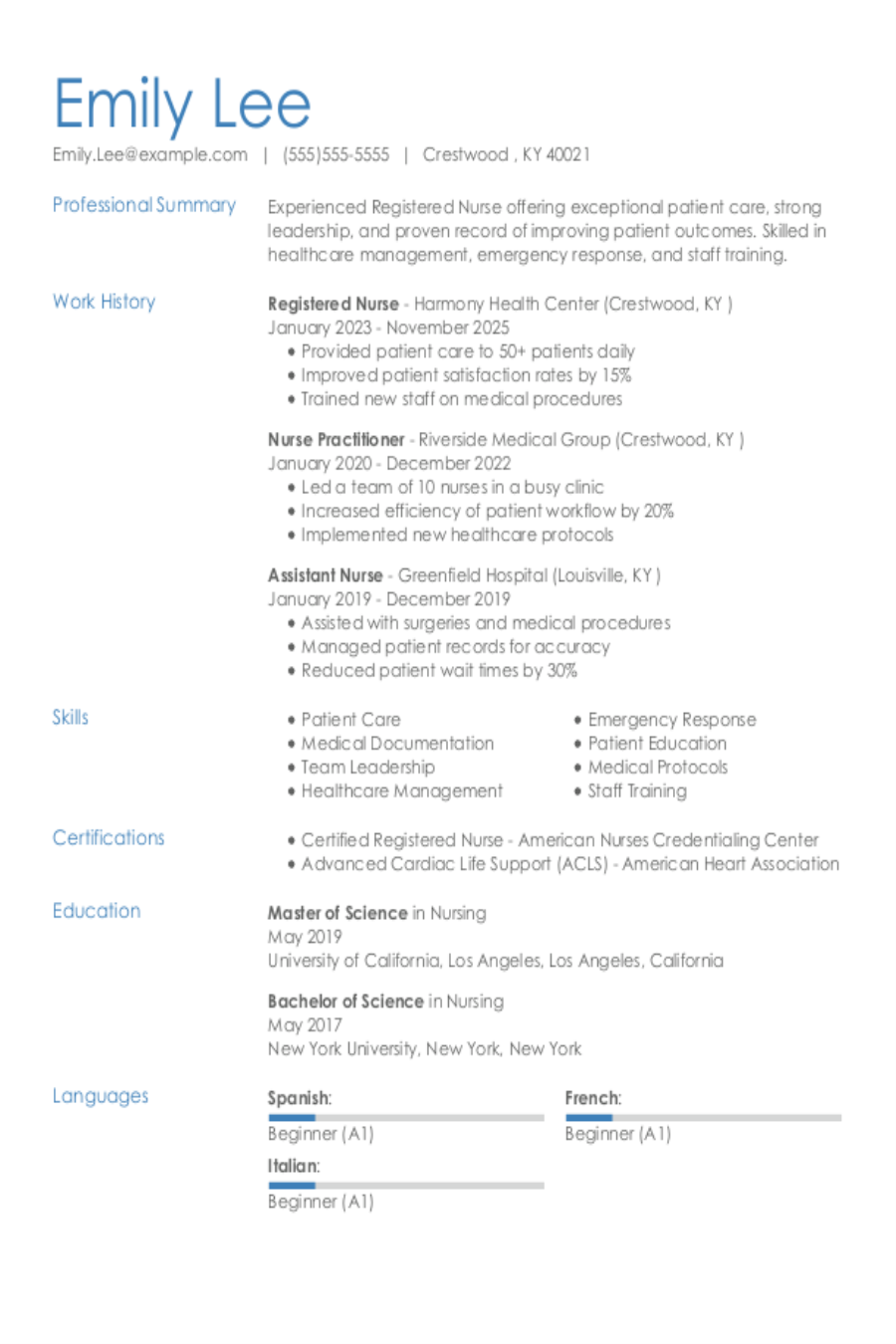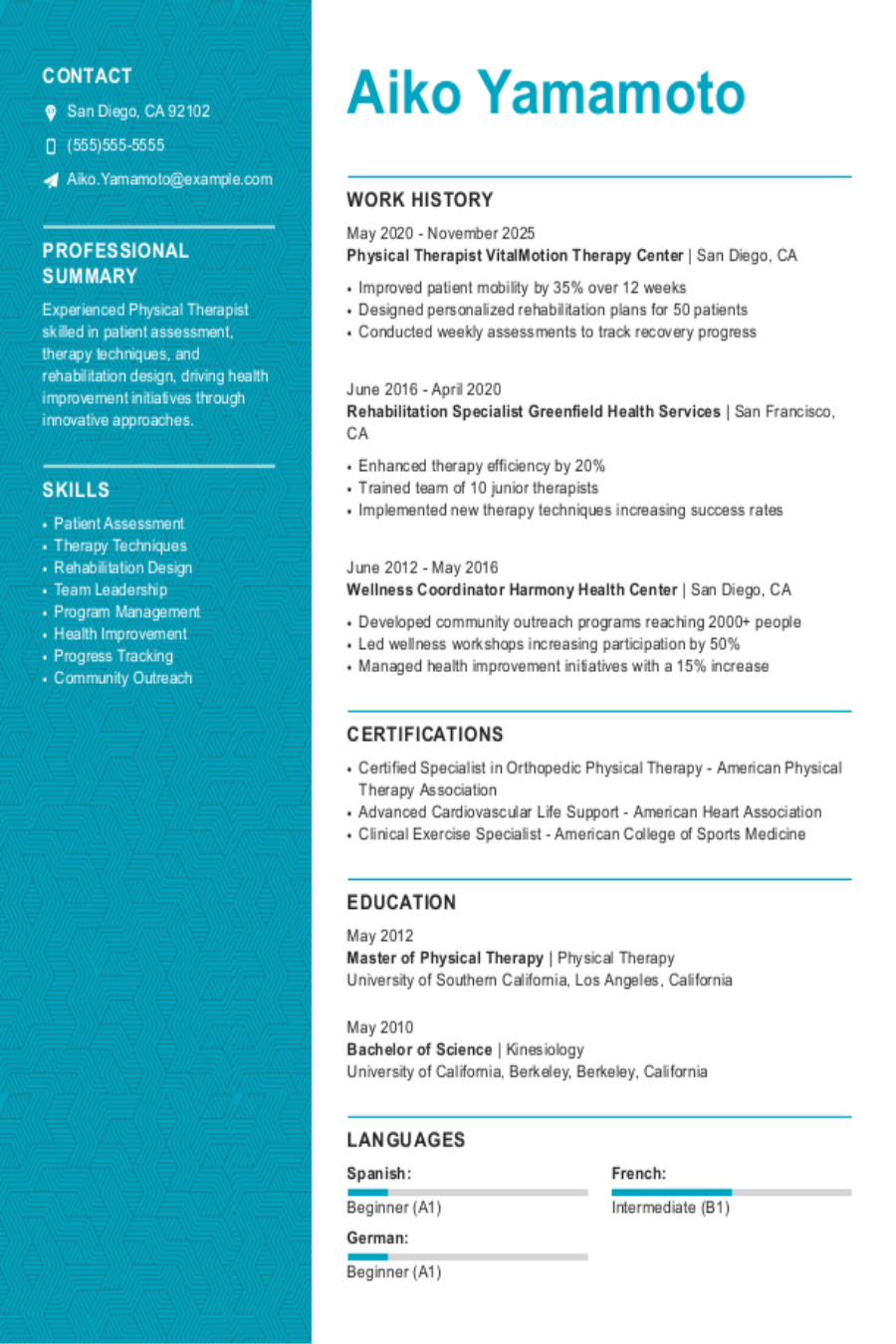Popular Perioperative Nurse Resume Examples
Entry-level perioperative nurse resume
An entry-level resume for a perioperative nurse should emphasize clinical skills, relevant coursework, certifications, and any hands-on training to show readiness for the fast-paced surgical environment.
Showcases education: This resume highlights the education section early on, giving the candidate’s qualifications a chance to stand out from the start.
Emphasizes soft skills: This resume highlights the job seeker's strong soft skills such as collaboration and patient-centered care, which are important for a perioperative nurse.
Mid-career perioperative nurse resume
A mid-career perioperative nurse resume should emphasize a combination of clinical expertise, leadership abilities, and ongoing education to effectively demonstrate professional growth and adaptability in the surgical environment.
Includes mix of skills: This resume effectively highlights the applicant's extensive technical skills in surgical care alongside strong interpersonal abilities, showcasing a well-rounded professional adept at improving patient safety and team collaboration.
Encourages quick scanning: A clean and well-structured resume allows hiring managers to quickly identify key qualifications and accomplishments, showcasing the applicant's expertise in perioperative nursing effectively.
Experienced perioperative nurse resume
An experienced perioperative nurse resume should highlight clinical skills, successful surgical outcomes, and ongoing professional development to effectively demonstrate career achievements and growth in the field.
Embraces modern design: This modern resume template effectively highlights the applicant’s commitment to excellence and innovation in perioperative nursing, emphasizing their extensive experience and ability to improve patient care efficiently.
Highlights experience: The resume's opening summary effectively showcases the job seeker's decade-long experience as a dedicated perioperative nurse. It immediately establishes authority in surgical procedures and patient care, setting a professional tone that resonates throughout the rest of the document.
No experience perioperative nurse resume
A resume for an applicant with no experience as a perioperative nurse should highlight relevant skills, certifications, and any clinical training to showcase the applicant's preparedness for the demanding environment of surgical care.
Uses a simple style: The resume's streamlined format highlights relevant nursing qualifications and volunteer experiences, ensuring clarity without unnecessary distractions.
Avoids jargon: Job seekers often think using complex terms or embellishing simple tasks will make their resumes stand out. However, this resume's straightforward and honest approach is much more effective in showcasing relevant experience and skills, making it easier for employers to see the job seeker's true potential.
More resume examples
Additional Guides
- Licensed Practical Nurse
- Medical Surgery Nurse
- Neonatal Intensive Care Nurse
- New Grad Nurse
- Nurse Manager
- Nurse Midwife
- Nurse Practitioner
- Nurse Supervisor
- Occupational Health Nurse
- Oncology Nurse
- Operating Room Nurse
- Pediatric Nurse
- Post Anesthesia Nurse
- Progressive Care Nurse
- Registered Nurse
- RN Unit Manager
- School Nurse
- Student
- Travel Nurse
- Utilization Review Manager
Perioperative Nurse Resume Template
Looking to create a standout application? Begin with this professional perioperative nurse resume template, which you can easily personalize with your unique qualifications and experiences.
Hiro Wilson
Austin, TX 78701
(555)555-5555
Hiro.Wilson@example.com
Professional Summary
Dedicated perioperative nurse with over 4 years of experience in surgical assistance, patient care, and infection control. Proven track record of reducing turnaround times and increasing patient safety, trained in advanced cardiovascular life support.
Work History
Perioperative Nurse
Harmony Health Center - Austin, TX
May 2023 - October 2025
- Assisted in over 300 surgeries annually with a 99% success rate
- Developed preoperative plans, reducing prep time by 15%
- Trained 10 new staff nurses in perioperative care protocols
Surgical Nurse
Riverside Medical Group - Pinehill, TX
February 2021 - April 2023
- Performed preoperative assessments for over 200 patients
- Managed operating room equipment, ensuring 100% readiness
- Collaborated with surgeons to enhance surgical efficiency by 10%
OR Nurse
Greenfield Hospital - Houston, TX
October 2019 - January 2021
- Monitored patient vitals during over 150 surgeries
- Optimized recovery room processes, reducing turnaround time by 20%
- Conducted postoperative care, decreasing complications by 5%
Skills
- Patient Care
- Surgical Assistance
- Postoperative Care
- Infection Control
- Preoperative Planning
- Medical Equipment Management
- Team Training
- Patient Assessment
Education
Master's Degree Nursing
University of California, San Francisco San Francisco, California
May 2019
Bachelor's Degree Nursing
University of California, Los Angeles Los Angeles, California
May 2017
Certifications
- Certified Perioperative Nurse - Competency & Credentialing Institute
- Advanced Cardiovascular Life Support - American Heart Association
Languages
- Spanish - Intermediate (B1)
- French - Beginner (A1)
- German - Beginner (A1)
Writing Your Perioperative Nurse Resume
Having explored these effective resume examples, you’re now prepared to dive into the process of how to write a resume. We’ll walk you through each section in detail, ensuring you feel confident and ready to create your own standout document.
List your most relevant skills
An effective skills section for your perioperative nurse resume should focus on both technical skills, such as knowledge of surgical procedures and patient care, and essential soft skills like teamwork and communication. By aligning your skills with the keywords from the job listing, you demonstrate to recruiters that you are well-suited for the role.
This not only helps human recruiters quickly identify your fit for the position, but it also improves your chances of passing through applicant tracking systems. Tailoring this section effectively will highlight what makes you an ideal job seeker for a perioperative nursing role.
Example of skills on a perioperative nurse resume
- Proficient in assisting with surgical procedures and understanding sterile techniques
- Adept at monitoring patient vital signs and responding to emergencies
- Strong communicator who collaborates effectively with surgical teams
- Compassionate caregiver focused on patient comfort and safety
A strong skills section is important for showing your readiness as a perioperative nurse. It should include both the technical skills outlined in the job description and essential soft skills, emphasizing your ability to manage patient care effectively and collaborate within a surgical team. This combination demonstrates your well-rounded preparation for the role.
Highlight your work history
Your work experience section should focus on tangible achievements that demonstrate your capabilities in the operating room environment. Use specific examples to illustrate how you've impacted patient outcomes and collaborated with surgical teams, ensuring you incorporate relevant terminology that aligns with the role.
For each job entry, include essential details like your title, employer’s name, and employment dates. This foundational information allows hiring managers to quickly assess your professional background and expertise.
Example of a perioperative nurse work experience entry
- Perioperative Nurse
City Hospital - New York, NY
June 2021 - Present - Assist in over 150 surgical procedures annually, ensuring adherence to sterile techniques and patient safety protocols
- Collaborate with surgeons and anesthesiologists to develop patient care plans, improving surgical outcomes by 20%
- Educate patients and families on pre-operative and post-operative care, contributing to a 30% decrease in readmission rates
- Mentor new nursing staff on perioperative best practices and emergency response procedures, improving team efficiency by 15%
- Implement quality improvement initiatives that resulted in a 25% reduction in surgical site infections within one year
Highlighting outcomes and achievements in your experience section is vital, as it showcases your impact on patient care and surgical outcomes. Employers are drawn to measurable results that demonstrate your ability to improve team performance and improve operational efficiency. By emphasizing accomplishments over mere responsibilities, you reveal your potential to contribute meaningfully to their organization.
Include your education
The education section of your perioperative nurse resume should detail your academic qualifications in reverse-chronological order, starting with the most recent degree. Include relevant degrees and certifications while leaving out your high school diploma if you've completed a higher level of education.
For ongoing education, be sure to list your highest completed degree along with an expected graduation date if applicable. It can also be beneficial to include bullet points showcasing relevant coursework or academic achievements, particularly when you are a current student or recent graduate.
Common certifications for a perioperative nurse resume
- Certified Perioperative Nurse (CNOR) – Competency & Credentialing Institute (CCI)
- Certified Surgical Services Manager (CSSM) – Competency & Credentialing Institute (CCI)
- Advanced Cardiac Life Support (ACLS) – American Heart Association
- Basic Life Support (BLS) – American Heart Association
Sum up your resume with an introduction
Your resume profile serves as an essential introduction to your career, setting the stage for potential employers by highlighting your key qualifications. It's the first section they see, so it needs to make a strong impression.
If you are an experienced perioperative nurse, a professional summary is ideal to spotlight your accomplishments. This approach allows you to emphasize significant achievements and experiences that demonstrate your expertise in surgical procedures and patient management. If your experience is still growing, write a resume objective that underscores your commitment to learning and improvement.
Professional summary example
Compassionate perioperative nurse with over 5 years of experience in diverse surgical settings. Demonstrated ability to improve patient outcomes through careful pre-operative assessments, effective communication with surgical teams, and adherence to stringent safety protocols. Proficient in managing anesthesia care and ensuring a smooth recovery process for patients.
Resume objective example
Compassionate perioperative nurse eager to apply strong patient care, teamwork, and critical thinking skills in a fast-paced surgical environment. Committed to improving patient safety and comfort while supporting surgical teams to ensure successful outcomes in every procedure.
When crafting your resume profile, begin with your job title as a perioperative nurse. This approach immediately conveys your professional identity and helps employers quickly understand your expertise in the field.
Add unique sections to set you apart
Optional resume sections can help you highlight your unique qualifications as a perioperative nurse. These additional components provide an opportunity to showcase what sets you apart in your career.
By including relevant hobbies or volunteer work, you reveal different aspects of your professional identity. Activities that align with your values not only illustrate your commitment to patient care but also demonstrate essential skills such as teamwork and leadership.
Three sections perfect for a perioperative nurse resume
- Languages: As a perioperative nurse, effective communication with diverse teams is essential. Highlighting your fluency in multiple languages can improve patient care and collaboration. For more tips on how to showcase language skills, consider adding them prominently on your resume.
- Volunteer Work: Including volunteer work on a resume not only highlights your dedication to community service but also showcases essential skills like teamwork and leadership, improving your appeal to employers.
- Accomplishments: As a perioperative nurse, measurable results are vital for demonstrating your effectiveness in patient care and surgical outcomes. You can add these achievements to your work history bullet points or make a unique accomplishments section to house them.
5 Resume Formatting Tips
- Choose a format that matches your career stage.
Choosing the right resume format is key to showcasing your experience as a perioperative nurse. If you're seasoned in the field, a chronological format highlights your career progression effectively. For those just starting out or with varied experiences, a functional resume can emphasize relevant skills. Consider a combination format for an approach that captures both aspects well-roundedly.
- Pick a smart resume template.
Using a professional resume template can significantly improve the readability of your application. It helps organize your information clearly, making it easier for hiring managers to identify your qualifications. Choose an ATS-friendly design that maintains simplicity and clarity, allowing your unique skills to shine through without distractions.
- Select an appropriate font.
Opt for a clean and professional font to improve your resume's readability. Fonts like Arial, Calibri, or Helvetica are excellent choices that appeal to both hiring managers and ATS.
- Use consistent formatting.
Ensure your resume is neatly aligned with uniform margins. This creates a polished look that grabs attention and reflects your professionalism as a perioperative nurse.
- Keep your resume to one or two pages.
When crafting your resume, remember that resumes should be one page long. This approach helps you concentrate on the key skills and experiences that matter most to employers. Keep it clear and concise to make a strong impression.
Tools for Your Job Search
Are you preparing to apply for that exciting perioperative nurse position? Before you hit submit, consider using our ATS Resume Checker. This tool offers helpful insights into how your resume will fare against the automated screening systems used by many healthcare facilities.
Need further assistance with your resume? Our AI Resume Builder provides tailored content recommendations specific to your nursing experience, along with professional templates designed to highlight your surgical skills and clinical expertise effectively.
Frequently Asked Questions
Last Updated: November 3, 2025
Absolutely. A cover letter is important as it provides essential context to your resume and fosters communication opportunities with employers. It allows you to express your passion for the perioperative nursing role and detail how your skills and experiences make you an ideal applicant. Don’t hesitate—write a cover letter that showcases your unique qualifications.
For a quick and effective way to create your cover letter, try our AI Cover Letter Generator. It helps you craft a personalized, job-winning cover letter in minutes, complete with matching cover letter template options that align perfectly with your resume, ensuring a polished presentation of your credentials.
A resume is typically a concise document spanning one to two pages, while a CV (curriculum vitae) can extend over several pages. Resumes highlight your skills and experiences relevant to the job you're applying for, whereas CVs provide an exhaustive account of your academic achievements, research contributions, and professional history.
CVs are usually required for positions in academia or specialized fields such as law and medicine. If you're considering applying for such roles, our online CV Maker is an excellent resource. It allows you to create tailored CVs quickly with various CV templates suited for different industries and career levels, ensuring you make a strong impression.
To make an impressive perioperative nurse resume, select a polished, professional template and integrate essential keywords from the job description. This strategy will showcase your qualifications and align you with the employer's needs.
For a perioperative nurse, maintaining an active LinkedIn profile is important. It helps expand your professional network and effectively showcases your specialized skills to potential employers.
To improve your networking skills as a perioperative nurse, keep in touch with former colleagues and reach out regularly. Consider joining nursing associations specific to perioperative roles. Updating your LinkedIn profile ensures you remain visible and engaged within the healthcare community.
Continuously improve your skills as a perioperative nurse by pursuing certifications and attending specialized workshops. Engage with professional associations to network and stay updated on best practices. Regularly read industry publications and participate in online training programs to remain knowledgeable about the latest surgical techniques and technologies.
Was this information helpful? Let us know!
Hailey is a career advice writer dedicated to helping job seekers excel in their careers.
More resources

RoboBossing: 66% of Workers Say AI in Leadership Would Make the Workplace More Fair and Efficient
Resume Now s latest report finds growing support for thoughtfu...

How to Write a Resume for a Career Change
Need a resume to showcase your unique career path? Our guide c...

How to Make a Skills Based Resume: Guide With Sample Resumes
View our guide to skills-based resumes to learn how a function...

Marketing Resume: Examples, Templates & Tips
Need a marketing resume that represents your personal brand? O...

Nursing Resume: Examples & Templates for 2025
Planning to pursue a nursing career? Let our samples template...

Physical Therapy Resume: Examples, Templates and Tips
Our physical therapy resume examples will help you kick-start ...

